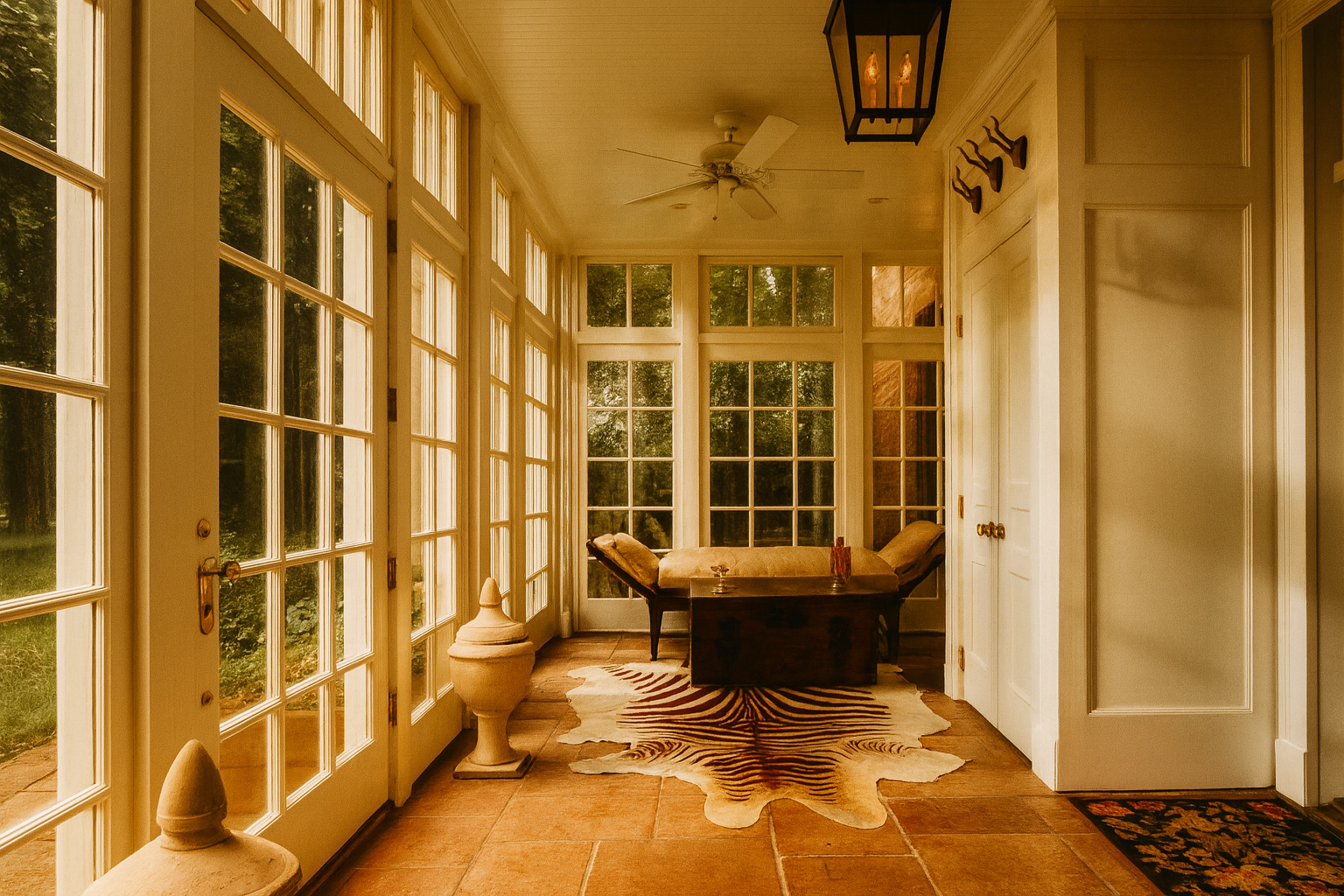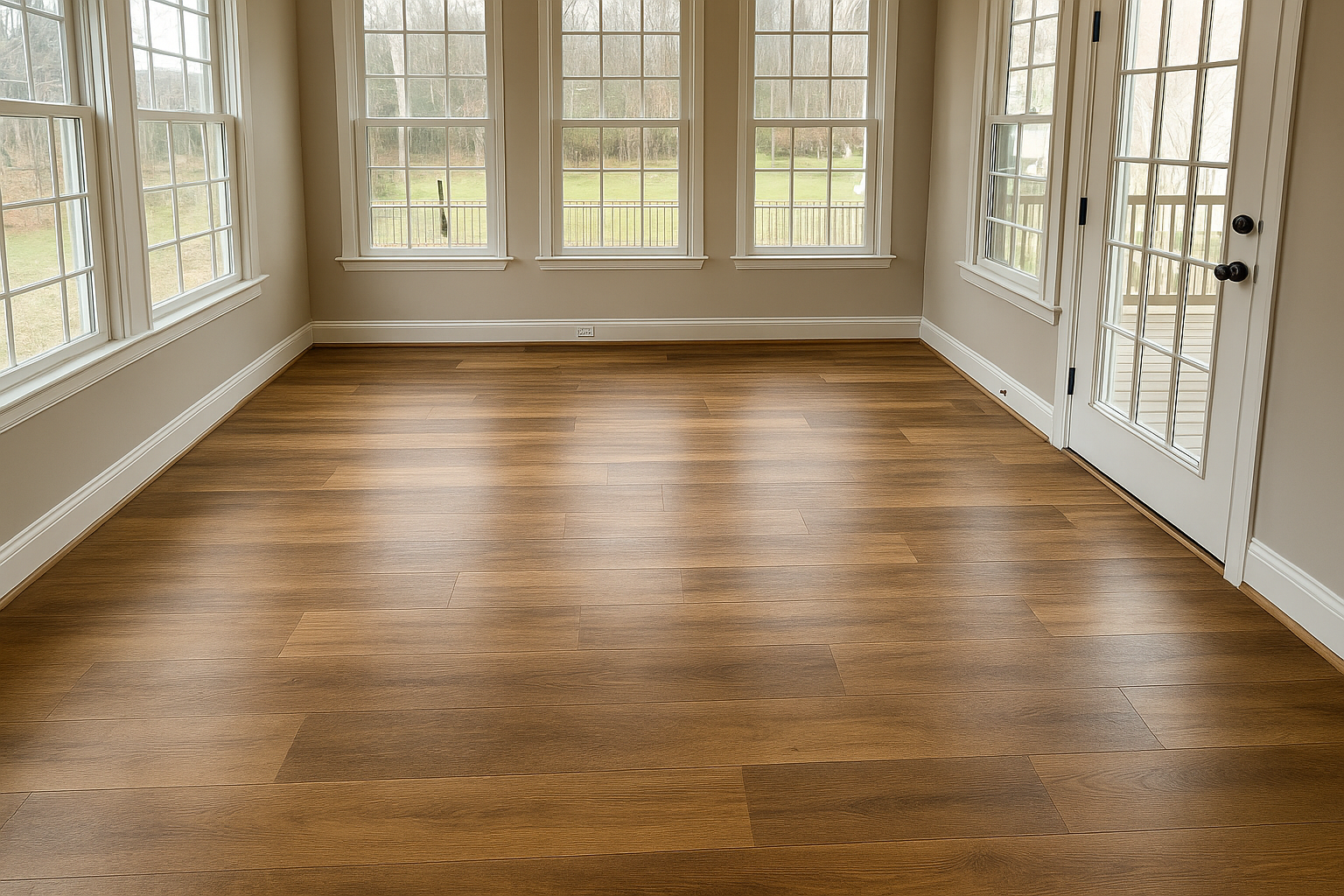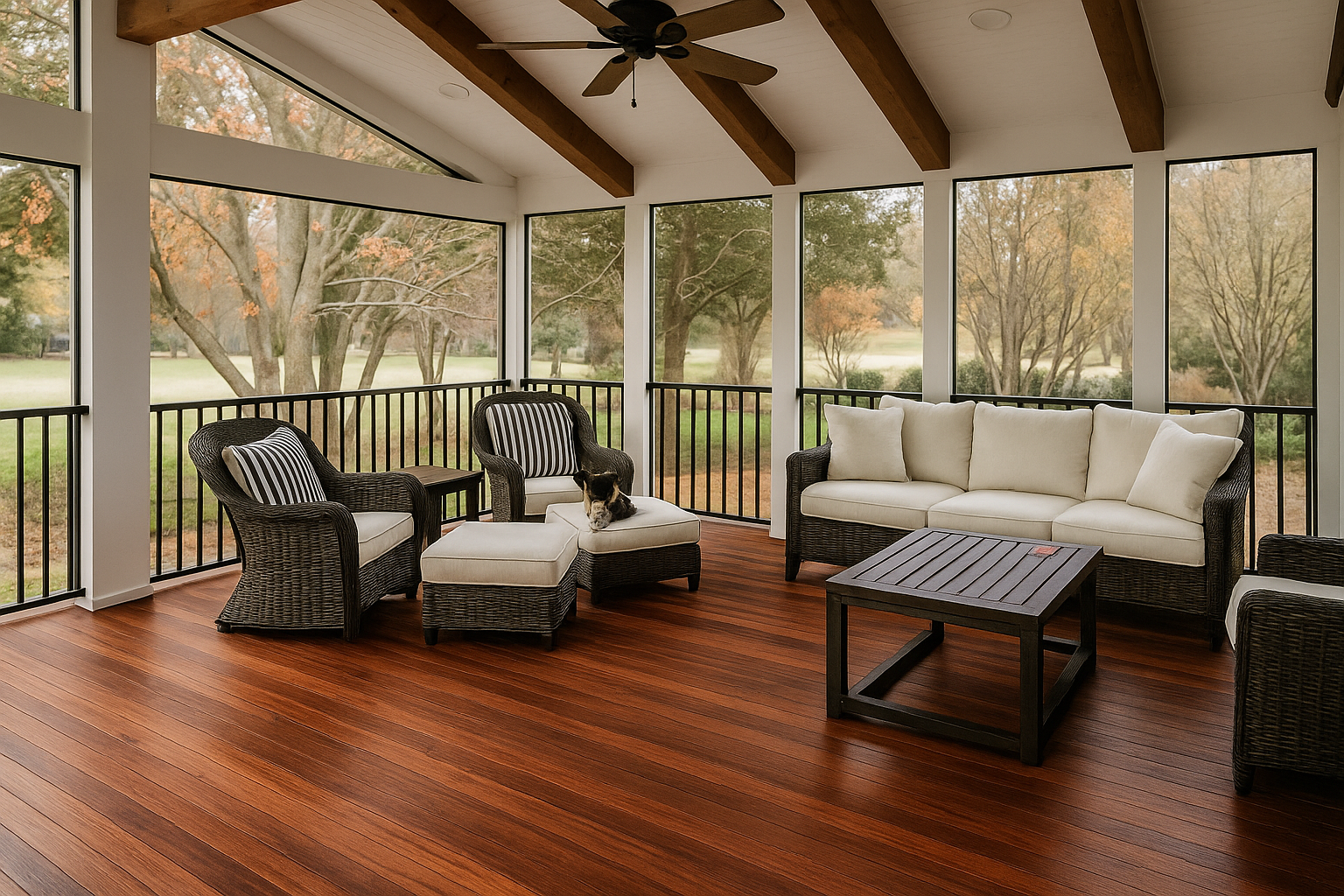Sunrooms are great until the temperature swings start working against your floors. Too hot in summer, too cold in winter – an unheated space puts flooring to the test.
Some materials handle it just fine, others not so much.
That’s why it pays to know which options will last. We’ll look at the best flooring for unheated sunrooms, what works well, and what to steer clear of.
Our Top 3 Picks
1. Tile Flooring
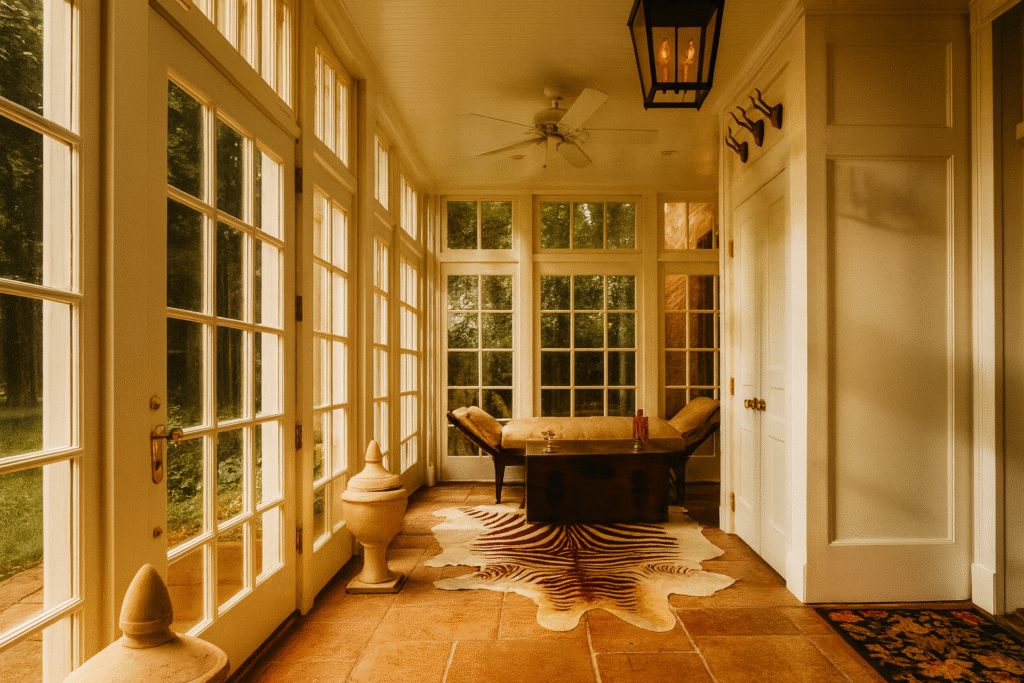
Tile flooring is one of the most dependable options for unheated sunrooms.
Whether you go for ceramic, porcelain, or natural stone, tile stands up to fluctuating temperatures, bright sunlight, and high humidity without warping or fading. Its resilience makes it a smart pick for spaces that connect indoor comfort with outdoor exposure.
Beyond durability, tile gives you nearly endless design possibilities. From sleek porcelain slabs to rustic slate or wood-look tiles, you can match the exact mood of your sunroom while keeping maintenance simple.
Just know that while tile stays cool in hot months, it can feel chilly in colder seasons unless paired with rugs or radiant heating.
Features
- Scratch and dent resistant
- UV-resistant with minimal fading
- Moisture-resistant and waterproof
- Naturally cool surface (great for hot climates)
- Requires grout lines that need periodic cleaning
- Compatible with radiant heating systems
Pros
- Extremely durable and long-lasting
- Retains color and style even under direct sunlight
- Excellent for high-traffic or pet-friendly homes
- Hypoallergenic surface that doesn’t trap dust or dander
- Wide variety of designs and finishes available
Cons
- Feels cold in winter or unheated climates without rugs or radiant heat
- Hard underfoot, less forgiving for long periods of standing
- Grout lines can stain or require regular upkeep
- Installation is costlier and more labor-intensive than vinyl or laminate
2. Luxury Vinyl Plank (LVP)
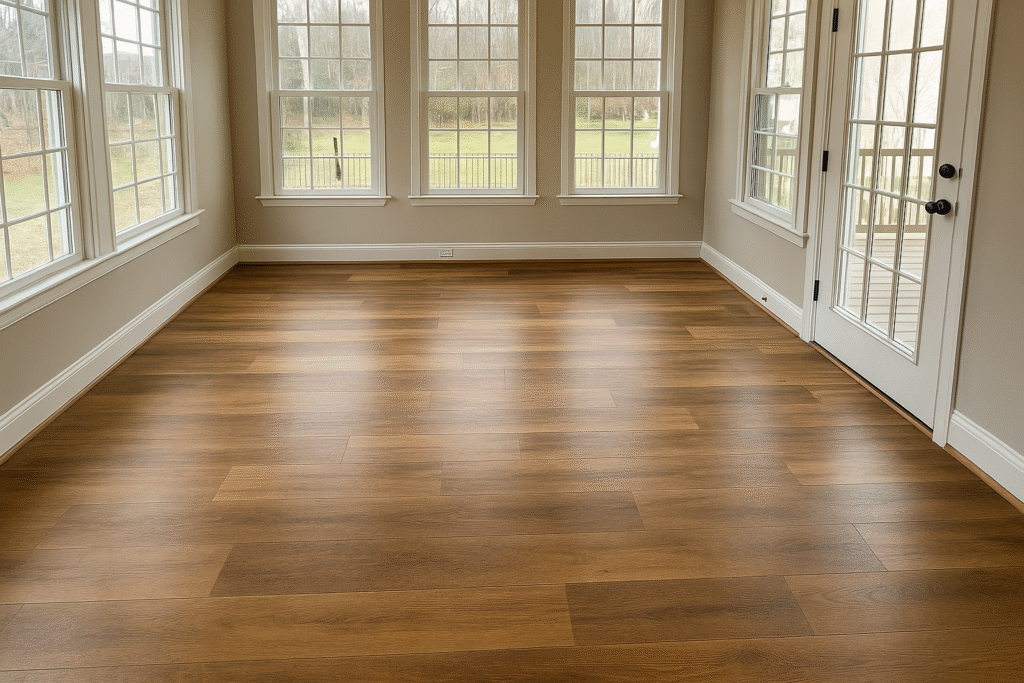
Luxury Vinyl Plank is one of the most versatile options for unheated sunrooms. It’s built to look and feel like natural hardwood, but with the waterproof durability of modern vinyl.
Thanks to its multi-layer construction, LVP resists moisture, handles fluctuating temperatures, and brings a warmer underfoot feel compared to tile or stone.
What makes it stand out is the balance between style and practicality. You get authentic wood visuals, scratch resistance, and easy cleaning – all at a more approachable price point.
For sunrooms, LVP with an SPC (stone plastic composite) core is the safest bet, since it offers extra stability in spaces without consistent heating or cooling.
Features
- 100% waterproof and moisture resistant
- Scratch- and stain-resistant wear layer
- Comfortable and warmer underfoot than stone or tile
- Easy maintenance with sweeping and mopping
- Wide variety of wood and stone looks
- Compatible with underfloor heating systems
Pros
- Withstands moisture and temperature swings without warping
- Affordable alternative to hardwood with a realistic look
- Durable against pets, kids, and moving furniture
- Easy to clean and low-maintenance
- Can be installed over many subfloor types
Cons
- Wear layer can still dent or scratch under sharp, heavy objects
- Some types (HDF core) less stable in extreme hot or cold compared to SPC
- Floating planks may feel slightly “bouncy” if subfloor isn’t perfectly level
- Direct, prolonged sun can cause some fading without window treatments
3. Engineered Hardwood
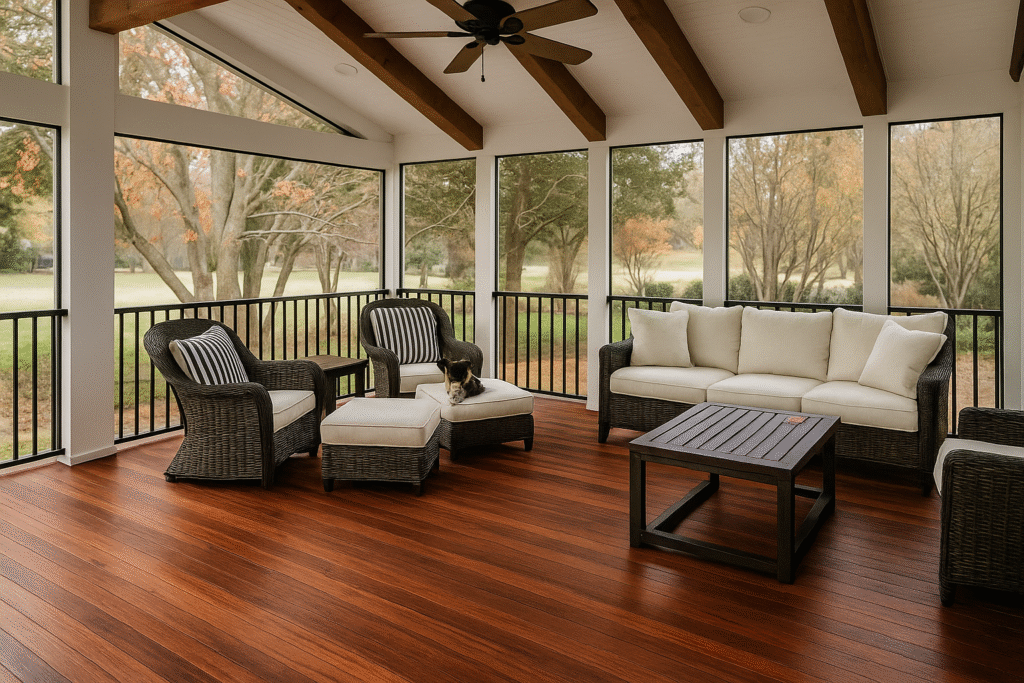
Engineered hardwood gives you the warmth and elegance of real wood but with more stability than traditional solid planks.
Its layered construction – a real hardwood veneer bonded to plywood or HDF layers – makes it less prone to warping, cupping, or shrinking when temperatures and humidity shift. That stability is exactly what unheated sunrooms need.
For homeowners who love the authentic look and feel of natural wood, engineered hardwood is a practical way to bring that charm into a sunroom without as much worry about seasonal damage.
With proper acclimation and installation, it can last for decades while maintaining a timeless appeal.
Features
- Real hardwood veneer top layer (2–6mm thick)
- Cross-grain plywood or HDF core for stability
- Total thickness typically 10–20mm
- Wear layer determines refinishing potential
- Handles moderate humidity changes better than solid hardwood
- Wide range of wood species, finishes, and colors
Pros
- More stable than solid hardwood in fluctuating climates
- Genuine wood look and feel adds warmth and value
- Easier to install (click-fit systems available)
- Can last 30–50 years with care
- More cost-effective than solid hardwood
- Can be refinished depending on veneer thickness
Cons
- Not fully waterproof – extended moisture exposure can cause damage
- Limited refinishing compared to solid wood
- Adhesives in some products may emit VOCs (opt for low-emission options)
- Extreme climate swings may still cause slight movement or surface cracks
- Requires moisture barrier and acclimation before installation
4. Laminate Flooring
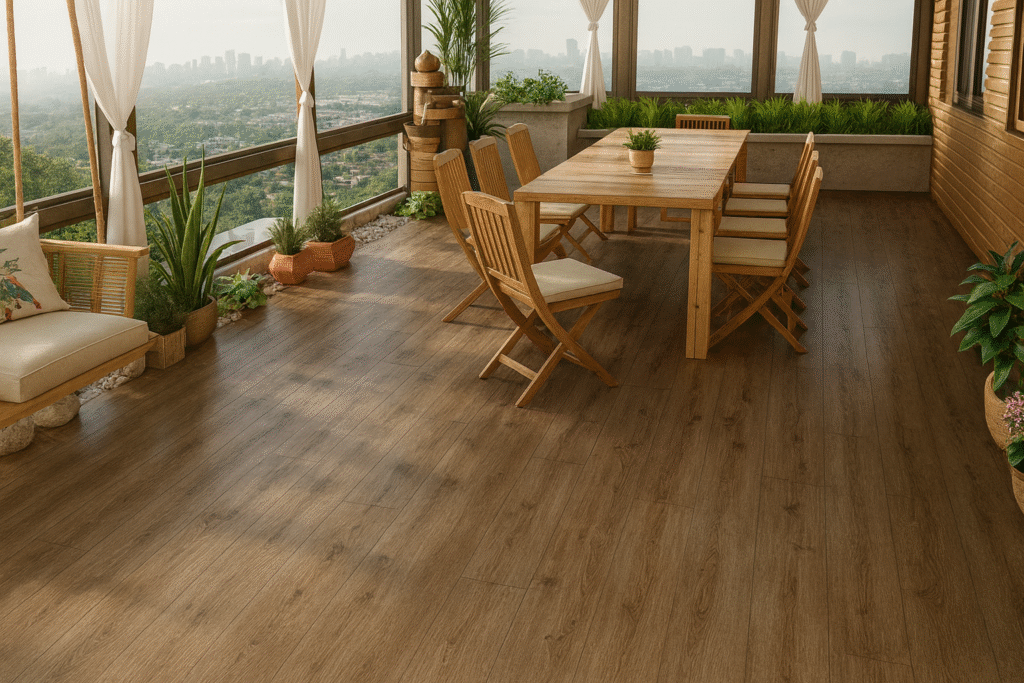
Laminate flooring is a go-to option when you want style on a budget. Built from a fiberboard core topped with a printed image layer and a protective wear layer, laminate can mimic hardwood, stone, or tile without the same price tag.
Its layered design also makes it more forgiving than solid hardwood when temperatures fluctuate – something unheated sunrooms deal with regularly.
For homeowners who want a simple, attractive, and low-maintenance surface, laminate checks a lot of boxes. Just keep in mind that while it handles expansion and contraction better than wood, it isn’t waterproof, so managing moisture is key.
Features
- Realistic wood, stone, or tile visuals
- Scratch- and dent-resistant surface
- Click-lock systems for easier DIY installation
- Simple sweeping and mopping maintenance
- Some products include UV protection to reduce fading
Pros
- Affordable compared to hardwood or tile
- Wide range of stylish looks and finishes
- Easier and quicker to install than other flooring types
- Durable against scratches and stains
- Less prone to cracking than hardwood in fluctuating climates
Cons
- Not waterproof – susceptible to swelling if exposed to moisture
- Can fade or discolor under prolonged direct sunlight
- Extreme temperature swings may still cause expansion issues
- Cannot be refinished; damaged planks must be replaced
- Can feel hollow or less natural underfoot without underlayment
5. Carpet Flooring
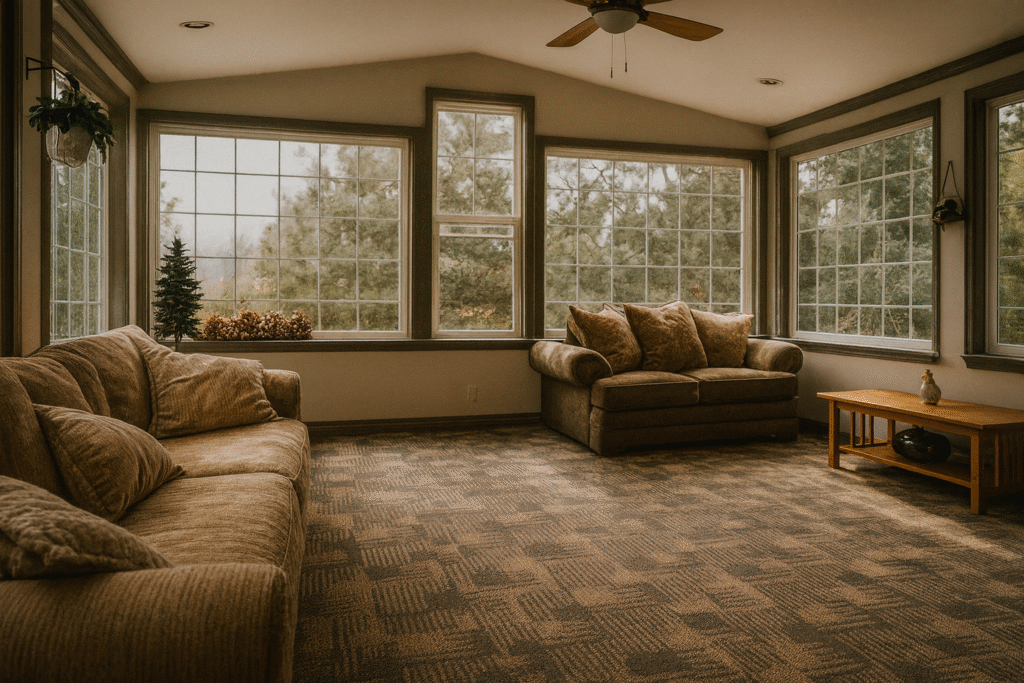
Carpet might not be the first flooring type you think of for a sunroom, but it does bring unique advantages – especially in unheated spaces.
Its natural insulation makes a room feel warmer during cool seasons, and its soft, cushioned surface creates a cozy, inviting atmosphere. Carpet also absorbs sound, which helps reduce echoes in a space surrounded by windows and hard surfaces.
The key is choosing wisely. Standard indoor carpet won’t hold up well, but indoor/outdoor varieties with UV- and fade-resistant fibers can be a practical way to add comfort without constant upkeep.
Features
- Wide range of colors, textures, and styles
- Indoor/outdoor variants offer better durability
- Options with UV- and fade-resistant fibers
- Provides sound absorption and insulation
- Requires regular vacuuming and occasional deep cleaning
Pros
- Adds warmth and coziness in cooler seasons
- Cushioned underfoot for comfort and safety
- Improves acoustics by reducing echo
- Generally affordable compared to other options
- Stays relatively cool in hot weather
Cons
- Susceptible to staining, fading, and discoloration
- Moisture can lead to mold or mildew if not managed
- Requires more maintenance than hard surfaces
- Not as durable as tile, vinyl, or engineered hardwood in sunrooms
- Even UV-protected carpets will eventually fade over time
Comparison: Best Flooring for Unheated Sunrooms
| Decision Criteria | Tile | LVP | Engineered Hardwood | Laminate | Carpet |
|---|---|---|---|---|---|
| Waterproof for tracked-in rain | ✔️ | ✔️ | ❌ | ❌ | ❌ |
| Resists UV fading in sunny rooms | ✔️ | ✔️ | ❌ | ❌ | ❌ |
| Stable in temperature swings | ✔️ | ✔️ | ✔️ | ✔️ | ✔️ |
| Comfortable under bare feet | ❌ | ✔️ | ✔️ | ✔️ | ✔️ |
| Feels warmer in winter (without heat) | ❌ | ✔️ | ✔️ | ✔️ | ✔️ |
| Works with radiant floor heating | ✔️ | ✔️ | ✔️ | ✔️ | ✔️ |
| Low maintenance week to week | ✔️ | ✔️ | ❌ | ✔️ | ❌ |
| DIY-friendly install | ❌ | ✔️ | ✔️ | ✔️ | ❌ |
| Budget-friendly overall | ❌ | ✔️ | ❌ | ✔️ | ✔️ |
| Long lifespan potential | ✔️ | ✔️ | ✔️ | ❌ | ❌ |
| Pet and scratch resistance | ✔️ | ✔️ | ❌ | ✔️ | ❌ |
How to Choose the Best Flooring for an Unheated Sunroom
1. Temperature & Climate Resistance
Sunrooms see some of the widest swings in a home – scorching in summer and frigid in winter. Floors that can handle those changes without warping or cracking are essential.
- Best performers: Tile and LVP hold up extremely well, staying dimensionally stable no matter the season. Engineered hardwood is also a strong option, though still wood at its core.
- Less reliable: Laminate handles expansion better than solid wood but may still separate over time. Carpet won’t warp, but it won’t thrive in damp, cold corners either.
2. Moisture & Humidity Resistance
Tracked-in rain, condensation, or humid air can take a toll on the wrong material. Flooring that resists mold, mildew, and swelling lasts far longer in sunrooms.
- Best performers: Tile is naturally waterproof. LVP is 100% waterproof when installed correctly.
- Less reliable: Engineered hardwood can cope with minor humidity swings but not prolonged dampness. Laminate is vulnerable unless it has strong moisture protection. Carpet is the most at risk for mold and staining.
3. Durability & Traffic
Sunrooms often serve as transition spaces from outdoors to indoors, meaning dirt, pet paws, and heavy foot traffic are common.
Floors should withstand grit without looking worn in a year.
- Best performers: Tile is nearly indestructible, and LVP stands up well to scratches and moving furniture.
- Moderate: Engineered hardwood is durable but softer than tile or vinyl. Laminate resists scratches but can’t handle standing water.
- Least durable: Carpet shows wear quickly with tracked-in debris and needs frequent cleaning.
4. Sunlight & UV Exposure
Glass walls mean lots of natural light – and the risk of fading. UV resistance is key if you want your floors to look good long term.
- Best performers: Tile and UV-stabilized LVP resist fading well.
- Moderate: Engineered hardwood can keep its color if treated but may lighten over time. Laminate without UV protection is prone to discoloration.
- Least durable: Carpet fades the fastest, even with UV-treated fibers.
5. Comfort & Warmth
Floors should feel good underfoot. Sunrooms double as relaxation spaces, so comfort matters.
- Best performers: LVP and engineered hardwood balance warmth with resilience. Carpet offers the most comfort in cooler months.
- Less comfortable: Tile stays cool in summer but can be icy cold in winter unless paired with rugs or radiant heat. Laminate sits in the middle – comfortable but not cozy.
6. Aesthetics & Function
The look of your flooring sets the tone for the space. Whether you want a rustic garden feel, sleek entertaining space, or family playroom, style needs to pair with practicality.
- Best performers: Engineered hardwood brings natural warmth, while tile and LVP offer endless style versatility.
- More limited: Laminate looks convincing but lacks the texture of real wood or stone. Carpet adds coziness but struggles with longevity in bright, damp rooms.
What to Avoid in Unheated Sunrooms
Not every flooring type can handle the unique environment of an unheated sunroom. Two standouts to steer clear of are solid hardwood and cork.
Solid Hardwood
Traditional hardwood might look beautiful, but it’s not built for spaces with constant temperature swings and direct sunlight.
The planks expand and contract with heat and moisture, leading to warping, cupping, or cracking. UV rays also break down the finish and cause fading or darkening over time.
Even with protective coatings, the risks outweigh the rewards in an unheated sunroom.
Cork Flooring
Cork has natural warmth and comfort, but in a sunroom, it quickly loses its appeal.
UV exposure causes fading and surface breakdown, while temperature shifts make cork expand and contract.
Over time, this leads to cracks and deterioration, making it far less durable than alternatives like tile, vinyl, or engineered wood.
Frequently Asked Questions
Can I put area rugs on top of sunroom flooring?
Yes, area rugs work well in sunrooms, especially over tile or LVP to add warmth and comfort. Just make sure to use UV-resistant rugs and non-slip pads to prevent fading and movement.
Do unheated sunrooms need special underlayment for flooring?
In many cases, yes. A moisture barrier or insulating underlayment can help protect laminate, engineered hardwood, or vinyl from humidity while also improving comfort underfoot.
Is radiant floor heating worth it in a sunroom?
Radiant heating can make cold materials like tile much more comfortable in winter. It’s an added cost, but for sunrooms used year-round, it boosts comfort and usability.
How often should sunroom floors be replaced?
It depends on the material – tile and engineered hardwood can last decades, while carpet or laminate may need replacing every 10–15 years if exposed to heavy traffic and sunlight.
Conclusion
The best flooring for an unheated sunroom really depends on what matters most to you.
Tile handles moisture and sunlight better than almost anything. LVP balances comfort, style, and durability without the high price tag. Engineered hardwood gives you the real-wood look with more stability, while laminate works for budget-friendly updates. Carpet adds warmth, though it needs more upkeep.
Each choice has trade-offs, but knowing how your sunroom is used – season to season – makes the decision clearer.You can skip the guesswork by booking a free in-home appointment. We’ll bring flooring samples, look at your sunroom conditions, and give you a clear quote with financing options.


